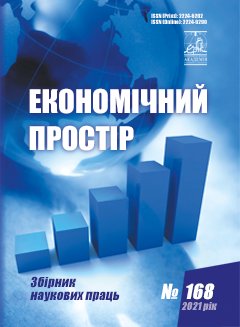НАСЛІДКИ COVID-19 ДЛЯ СВІТОВОЇ ЕКОНОМІКИ: ПЕРШІ ПІДСУМКИ 2020 РОКУ
Анотація
Метою статті є комплексна оцінка наслідків COVID-19 для світової економіки в розрізі окремих регіонів, індустрій та форм міжнародних економічних відносин. На початку 2020 р. світ охопила пандемія COVID-19. Задля збереження життів громадян та цілісності системи охорони здоров’я країни світу вимушені були вдатися до радикальних заходів – локдаунів, які включали повне чи часткове зупинення міжнародного сполучення та скорочення економічної активності. Такі дії мали негативний вплив на світову економіку: падіння світового виробництва, скорочення міжнародного попиту, зростання рівня безробіття та бідності, зменшення потоків прямих іноземних інвестицій. Ситуація досягла рівня Великої депресії 1930-х років. Криза COVID-19 по-різному уразила регіони світу, що й потребує ґрунтовного дослідження. Методологічну основу дослідження становлять як загальнонаукові, так і спеціальні методи наукового пізнання: описово-аналітичний, аналізу і синтезу, методи кількісних та якісних порівнянь. Інформаційною основою статті є дослідження та періодичні публікації зарубіжних учених-економістів, матеріали й аналітичні звіти міжнародних організацій. За результатами дослідження було встановлено, що світова економічна криза, спричинена COVID-19, почалася з Китаю, який ужив надзвичайно жорстких карантинних обмежень і вже на кінець 2020 р. демонстрував економічне зростання, і поступово поширилася на Європу, Північну Америку та решту країн світу. Найбільш відчутними були негативні наслідки COVID-19 для розвинених країн із високою часткою осіб похилого віку в загальній структурі населення, які є найбільш уразливими перед захворюванням. Європа – регіон, що постраждав чи не найбільше. Для Латинської Америки, Африки й частини країн Азії, що розвиваються, криза COVID-19 зумовила перманентні економічні проблеми та стихійні лиха: слабкість фінансової системи, великий обсяг державного боргу, високу залежність від цін на ринках сировини, нашестя сарани тощо. Розвинені країни були більш стабільні, тому проводили масштабні програми підтримки бізнесу та домогосподарств, особливо ефективними були програми кредитування та збереження робочих місць. Тоді як країни, що розвиваються, менше постраждали від поширення захворюваності, але не мали фінансового ресурсу для розгортання масштабних державних програм допомоги. З’явилися нові диспропорції у структурі світової економіки. Окремі галузі зазнавали величезних збитків і опинилися на межі виживання (туризм, готельно-ресторанний бізнес, сфера розваг тощо), суттєво збільшився рівень безробіття; інші, навпаки, працювали на повну потужність 24/7, і працівники вимушені були працювати понаднормово. Потоки прямих іноземних інвестицій скоротилися нижче рівня 2008–2009 рр. Найменше інвестицій надійшло у розвинені країни. Більшість прямих іноземних інвестицій припало на 2020 р. в операції злиття та поглинання, тоді як найбільше постраждало інвестування у наявні виробничі активи. Очікується збереження цієї тенденції й у 2021 р. За прогнозом, 2021 р. має закласти початок економічного відновлення, але вийти на рівень 2019 р. навряд чи вдасться. Результати роботи можуть бути використані у подальших наукових дослідженнях і практичному розробленні під час планування та реалізації антикризових стратегій країн.
Посилання
Ващенко А.В., Сидоренко К.В. Сучасні антикризові стратегії розвинених країн світу. Економічний простір. 2020. № 159. С. 24–27. DOI: https://doi.org/10.32782/2224-6282/159-4.
Грицюк Н.О., Сак Т.В. Вплив пандемії COVID-19 на світову економіку. Економічний простір. 2021. № 165. С. 33–38. DOI: http://www.prostir.pdaba.dp.ua/index.php/journal/article/view/780/757.
Protecting the life and health of workers during the COVID 19 pandemic: Overview of national legislative and policy responses. ILO, 2021. URL: https://www.ilo.org/global/research/publications/WCMS_767389/lang--en/index.htm.
Trade and Development Report 2020. From Global Pandemic to Prosperity for All: Avoiding Another Lost Decade. UNCTAD, 2020. URL: https://unctad.org/webflyer/trade-and-development-report-2020.
Aum S, Lee SY and Shin Y. COVID-19 doesn’t need lockdowns to destroy jobs: The effect of local outbreaks in Korea. Working Paper No. 27264. National Bureau of Economic Research, 2020. URL: https://www.nber.org/papers/w27264.
The Least Developed Countries Report 2020. Productive Capacities for the New Decade. UNCTAD, 2020. URL: https://unctad.org/system/files/ official-document/ldcr2020_en.pdf.
Blanchard, O., T. Philippon and J. Pisani-Ferry. A new policy toolkit is needed as countries exit COVID-19 lockdowns. Policy Contribution 12/2020, Bruegel. URL: https://www.bruegel.org/wp-content/uploads/2020/06/PC-12-2020-230620.pdf.
Credit Trends: Global Refinancing-Rated Corporate Debt Due Through 2025 Totals $11.3 Trillion. S&P (Standard & Poor), 2020. URL: https://www.spglobal.com/ratings/en/research/articles/210208-credit-trends-global-refinancing-rated-corporate-debt-due-through-2025-totals-11-3-trillion-11828370#:~:text=About%20%2411.3%20trillion%20in%20corporate,to%20mature%20globally%20through%202025.&text=New%20issuance%20in%202020%20contributed,which%20now%20totals%20%2422.1%20trillion.
World Investment Report 2020. International production beyond the pandemic. UNCTAD, 2020. URL: https://unctad.org/system/files/official-document/wir2020_en.pdf.
Global foreign direct investment fell by 42% in 2020, outlook remains weak. UNCTAD, 2020. URL: https://unctad.org/news/global-foreign-direct-investment-fell-42-2020-outlook-remains-weak.
Vashchenko A.V., Sydorenko K.V. (2020) Suchasni antykryzovi stratehii rozvynenykh krain svitu. Ekonomichnyi prostir. no. 159. рр. 24-27. DOI: https://doi.org/10.32782/2224-6282/159-4 (in Ukrainian).
Hrytsiuk N.O., Sak T.V. (2021) Vplyv pandemii COVID-19 na svitovu ekonomiku. Ekonomichnyi prostir. no. 165. рр. 33-38. DOI: http://www.prostir.pdaba.dp.ua/index.php/journal/article/view/780/757 (in Ukrainian).
Protecting the life and health of workers during the COVID 19 pandemic: Overview of national legislative and policy responses. ILO (2021). Available at https://www.ilo.org/global/research/publications/WCMS_767389/lang--en/index.htm
Trade and Development Report 2020. From Global Pandemic to Prosperity for All: Avoiding Another Lost Decade. UNCTAD (2020). Available at https://unctad.org/webflyer/trade-and-development-report-2020
Aum S, Lee SY and Shin Y (2020) COVID-19 doesn’t need lockdowns to destroy jobs: The effect of local outbreaks in Korea. Working Paper No. 27264. National Bureau of Economic Research. Available at https://www.nber.org/papers/w27264
The Least Developed Countries Report 2020. Productive Capacities for the New Decade. UNCTAD (2020). Available at https://unctad.org/system/files/ official-document/ldcr2020_en.pdf
Blanchard, O., T. Philippon and J. Pisani-Ferry. A new policy toolkit is needed as countries exit COVID-19 lockdowns. Policy Contribution 12/2020, Bruegel (2020). Available at https://www.bruegel.org/wp-content/uploads/2020/06/PC-12-2020-230620.pdf
Credit Trends: Global Refinancing--Rated Corporate Debt Due Through 2025 Totals $11.3 Trillion. S&P (Standard & Poor) (2020). Available at https://www.spglobal.com/ratings/en/research/articles/210208-credit-trends-global-refinancing-rated-corporate-debt-due-through-2025-totals-11-3-trillion-11828370#:~:text=About%20%2411.3%20trillion%20in%20corporate,to%20mature%20globally%20through%202025.&text=New%20issuance%20in%202020%20contributed,which%20now%20totals%20%2422.1%20trillion.
World Investment Report 2020. International production beyond the pandemic. UNCTAD (2020). Available at https://unctad.org/system/files/official-document/wir2020_en.pdf
Global foreign direct investment fell by 42% in 2020, outlook remains weak. UNCTAD (2020). Available at https://unctad.org/news/global-foreign-direct-investment-fell-42-2020-outlook-remains-weak



